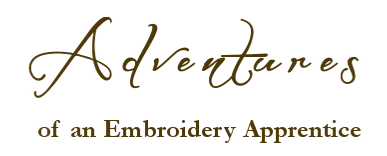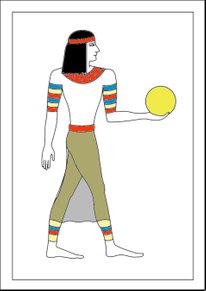Click on the images to enlarge them!
February - March 2020
Egypt
This was a long time evolving project. My inspiration for this series was Albert Racinet's Weltgeschichte der Kostüme (The Costume History - I have no idea, why the author is called Albert in some sources and in others Auguste ... 🤔 ... in my copy it is Albert ... ah! always ask Wikipedia: his full name is Albert Charles Auguste!), which I poured half a litre tea over, so that I had to buy a new one for the local library and could keep the old copy for myself - a Freudian mistake?
I knew I wanted to reproduce some of these gorgeous illustrations and possibly embroider them. I did my first vector design in last August, and even began to stitch it, but I could not come to grips with the issue, whether tracing and stitching an 150 years old illustration from a book from 1989 will be a violation of copyright or not?
Time and again I tried to draw my own design of an Egyptian. Eventually, around Christmas 2019, I got a version that I liked. It was lingering about till February 9, when I finally started to embroider it.
Egyptian Costume, Design
The New Iron-on Pen
I couldn't resist. I had to get it. What? The Sublime Stitching Fine Tip Iron-on Transfer Pen, which Mary Corbet and other stitchers were so full of praise of. The reason for my long-time procrastination were the shipping charges from the USA to Germany, of course. But what are birthdays for? After having been gifted with a decent amount of money from my family, I took the plunge early this January and ordered the pen, together with a handful of Sublime Thread in order to make the purchase worthwhile. Aside from that, I'm always eager to try out new threads.
My Postman Had to Ring Just Once. 😁
And there it is! The floss was planned for this design (I had ordered some golden metallic thread, too), but first came the iron-on pen - let's try and see, if it's really that good.
Since my first transfer test run, I have learned some new things. For example, that the fabric should be pre-heated, that is, you simply iron it once before the actual transfer. What's more, it isn't necessary at all to use expensive good quality tracing paper for the transfer. You can trace the design directly on the printing paper, just make sure the print is mirror-inverted until the pattern isn't symmetrical.
Transfer
All this done, that is how the transfer turned out. There's a couple of incomplete lines, no idea why, but that's no problem - the lines are still well recognisable. I had hoped they would be finer, though. But re-reading Mary Corbet's review of the pen, I realised that she wrote: "The lines are fine enough to cover easily with two strands of floss". Oh well, I usually stitch with one strand only ...
All in all, the Sublime Stitching Fine Tip Iron-on Transfer Pen works very similar to the DEKA Bügelmusterstift I've been using to date. My main issue with the latter was the smudging, but that could easily be due to the fact, that I had never pre-heated the fabric. Somewhere along the line, I will definitely run a second test run with both to get a one to one comparison of the process and the results.
The Silky Way
My idea for this series was to fill the garments only, while the body parts would be outlined in black. Hence I stitched the outlines of the body with one strand of black floss in stem stitch. The fingers were a challenge, as the whole fellow stands merely 14.5 cm (5.7 ") tall, so that one finger is max 1 cm (0.4 ") long and 1 mm (0.04 ") thick. So the fingers might look a bit awkward, but they are as good as it gets.
When I was ready to pass to the black hair filling, there seemed to be too little lustre about the cotton floss. That was the point, when I felt like trying out silk floss for the first time. If you were following my embroidery process up to now, you might have learned that it is anything but easy to come by embroidery materials other than cotton floss in Germany. I had some rayon in my so called stash, and I would have used it, but there were no matching colours among it.
A long search led me eventually to success. I would have ignored the website, because the name is Werkstatt für Historische Stickmuster, that is Studio for Historic Embroidery Patterns, and I didn't expect an online shop behind a studio. As it turned out, I stumbled upon the official representation of Au Ver à Soie, the worldwide renowned manufacturer of silk embroidery thread in France. What a trove! From my Needle'n Thread lectures, I knew by now that the most recommendable silk thread for beginners is spun silk, and that would be Soie d'Alger in this case. (Incidentally, the beforementioned online shop also sells crewel wool! It is Au Ver à Soie Laine Fine d'Aubusson.)
My order arrived within three days. At first glance, I wasn't sold on it. It looked to me just like DMC stranded cotton, the only difference being the softness of the silk. While stitching the hair, I noticed, that it was even a bit thicker than cotton, which came as a surprise, because I had always imagined silk thread as an extraordinarily fine thread. This thickness was a pleasant thing, however, since it gives the silk a better coverage. It was only after stitching the whole shock of hair, when the scales fell from my eyes and I saw it: the lustre! Oh, what a lustre! Oh, the luscious colours! And just touch it - it is like stroking velvet! Working split stitch with this silk is pure pleasure, the needle passes through the thread like through butter.
Louis, I think this is the beginning of a beautiful friendship.
First Stitches with Silk
Clothing an Egyptian
As you can see in the design at the beginning of this article, my initial colour scheme was rather pale. As a matter of prudence, I had ordered two shades of every colour, except black - one paler, one more vibrant. Now, with the threads before my very eyes, I opted for the darker, more vibrant colour scheme. Not just that I liked them better, I was also thinking about the leggings beneath the skirt. The skirt was supposed to be semi-transparent, hence the leggings beneath it must be of a shaded, paler colour than the rest of it.
The hair is done in long-and-short stitch, the headband in stem stitch filling, and the collar is worked in separate interlocked triangles in satin stitch, which later became separated by black lines in split stitch.
The rings around the arms and ankles are done in satin stitch, too. It was quite fiddly to get them done close together, without a visible gap between them, but the black separation lines in split stitch covered the transitions nicely. By the way, everything in this piece is worked with one strand of silk.
At this point the legs come in. They gave me a bit of reflection. My idea was to fill the leggings beneath the skirt in a paler yellow in long-and-short stitch. But how to do a semi-transparent skirt? I know, there are some materials out there, kind of craft net, I just don't remember the name, plus I couldn't afford to buy more stuff. It had to be done with threads.
Once again, Thomas's Dictionary had to prove its worth. And it did. I found a stitch called honeycomb filling stitch, which I thought could do the job. So I grabbed a scrap of the same 50 ct. linen and did a test run of this stitch over a background done in long-and-short stitch.
The Honeycomb Filling Stitch - Test
To work the honeycomb filling stitch, you span a layer of parallel horizontal threads, then work a second layer of parallel diagonal threads on top of it, and finally lay a third layer of diagonal threads perpendicular to the second layer on top, which you weave through the already existing threads, passing your needle over the horizontal and under the diagonal threads.
The tricky thing, as I noticed practicing it, was to meet the right spacing at a slanted bottom line. A straight bottom line doesn't pose difficulties in estimating the regular spacing for parallel lines, but as soon as it gets slanted, the necessary spacing increases extremely. The whole process of spacing the threads in this skirt was a matter of trial and error.
Nevertheless, the test run worked out in the end, and I got down to fill the legs with long-and-short stitch in pale yellow up to the lower edge.
Leggings Finished - Now it's Neck or Nothing
In the photo above you can see the beginning of the first layer of the honeycomb filling stitch on the actual embroidery.
But what about the ball in his hand? I was fancying a golden ball. Not by chance had I ordered a skein of golden metallic thread at Sublime Stitching, too. As with several other materials (wool, silk) I had never used metallic threads before. I wasn't sure if the ball wouldn't be too large for a satin stitch, but I decided to take the risk.
Skirt Finished - Ball Outlined
In the photo above you can see the finished skirt. If I am to be honest, I was - and still am - excited by the result. It looks exactly as I had imagined it.
And you can see the ball outlined in split stitch with the same golden yellow silk as in the clothing.
I remembered a blog post on Needle'n Thread on a satin stitched dot. I studied it once again. There was a huge built-up of padding beneath the actual satin stitch, and I decided to do the same in order to give the ball some volume.
When I finished the padding, I realised with consternation, that it had built up on the backside into a distinct knob, while the front side remained perfectly flat. As I learned later, the problem can be avoided by working the padding not in satin stitch, but coming up with the needle right next to the spot where it has gone down. So as to work the padding stitches back and forth instead of working them all in the same direction.
The metallic thread was way too thin to satin stitch the surface of the ball with one strand only. I tried two strands in the needle, but it was still too little, so I worked it with three strands in the end.
Making a Golden Ball
At this stage, it still looks more or less good ...
I had observed it quite a few times, that my satin stitch uses to squeeze the shape. Come to think of it, the reason could be me going down with the needle into the fabric at an inwards angle in order to ensure an even outline. In the photo above, I had taken care of putting the needle straight down, and there was less squeezing, indeed.
But once the ball was finished, it was no longer a ball, not even an egg, but nothing but a lump of gold.
Mind a Lump of Gold?
This was the point where I did two things: First, ripped it out. Second, presented the problem in our Facebook community.
After all, I had attended Mary Corbet's advises: the last stitch shouldn't be much longer than the second last, just as much as to cover the rest of the outline. Had I left it out, the outline would be visible. Had I made it longer, the ball would look cut off.
Most of the community members stated, that it looks good, looks like a ball, take a break and stop complaining. 😆 That's all very well, but when Mary Corbet herself commented: "I think it looks quite good", she met my feelings exactly. It looked quite good, not really good. Anyway, I had ripped the whole thingamajig out already, and thought, I would fill it in circular stem stitch with the golden yellow silk first, in order to stabilise the circle at the least, and then we will see ...
In the meantime, I stitched the last detail: the red belt in stem stitch filling, outlined with black split stitch.
So be it a Golden Plate!
This is what came out. I liked it. To be completely sure, I asked the community once again for advise: should I leave it like that, or should I satin stitch it all over again with golden metallic? To my great surprise, there was a hail of comments, with 95 % decisively stating: "Leave the stem stitch!"
This, my friend, is the end. I think. Instead of an ancient Egyptian with a golden ball in his hand, I'm offering you an ancient Egyptian with a golden plate in his hand - or is it still a ball after all? A lady from the community suggested a circular couching with gold. I like the idea, but, in the words of a certain famous sword master: not today. I never couched gold threads up to now, thus the risk of an improvement for the worse is too high for my liking.
Besides, I want to keep my first designs as uncomplicated as possible. It is my wish to get more and more people interested in modern embroidery, and you don't start an education using complicated designs, do you? 🌞


